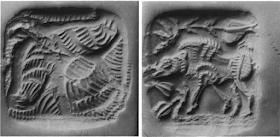Another fascinating object. This one was found in Tasmola V burial ground in Kazakhstan, also dated to 5th-4th century. BC. From this amazing resource (in Russian) "Язык звериных образов"
Why is this "fascinating" exactly? I hear you ask...Well, according to the archaeologists who discovered it the object itself is made in the form of the head of a bird of prey. Inside this shape there is a complex composition of many different animals....
The central, largest figure, is a wild boar. Under it, three heads of ibex goats and, possibly, a wolf are inscribed in the curves of the beak...
So we have:
Bird of pray (Vulture)
Wild boar
Ibex goat
Wolf
These animals were not picked randomly. All four animals have their mating season during the winter. Making this object a complex animal calendar marker representing winter (Nov, Dec, Jan)...
I already talked about the Ibex goats as animal calendar markers in my post "Combs from Tuva" about these two other very interesting combs from the same region and period.
I talked about Vultures and their mating season which made them one of the main animal calendar markers for winter and rain season in my posts "Pillar 43" about this pillar from Gobekli Tepe
And my post "Eagle dude from Aleppo", about these, well Eagle dudes from Aleppo and Nimrud
And I talked about the link between vulture and goat animal calendar markers in my post "Strider" about this amazing Proto-Elamite figurine
And I talked about wild boar and their mating season which makes them a symbol of winter in my post "Calydonian boar" about this Illyrian coin
And in my post "Roast pig for Christmas" about this Roman gem
And I talked about the link between the vulture and the wild boar calendar marker symbols in my post "Double headed eagle" in which I talked about this amazing axe head from Bactria
And in my post "Summer and winter BMAC seals" about this amazing Bactrian seal
But I never talked about wolves as animal calendar markers. Wolves typically mate between January and March...
MacBain's Gaelic dictionary says that period from mid January to mid February was once called "faoilleach", "faoillteach", Irish "faoillidh", "faoilleach"...From "faol", wolf, meaning "wolf-month"...The month when wolves mate...
Anglo-saxons also called January (probably again month from mid January to mid February) Wulf-monath (meaning "wolf month"). For the same reason: wolves are much louder and more noticeable in January, which is when breeding season begins...
Interestingly, in Serbian tradition, 14th of January (Julian) or 27th of January (Gregorian) calendar, is the day of the Serbian patron saint, St Sava...
St Sava's cult replaced the cult of the Serbian supreme god Dabog who was known among other things as "Wolf Shepherd". Both originally Dabog and later St Sava were believed to be able to command the wolves who and when to attack, and whom not to attack...
St Sava is just one, the main, of several Serbian "Wolf Saints" which are all celebrated during the winter...And St Sava, the Wold Shepherd, is celebrated right at the beginning of the wolf mating season...
So, the very strange and interesting object found in Tasmola V burial ground in Kazakhstan, deliberately combined all the animals which mate during winter and were because of that used as symbols for winter throughout Eurasia for thousands of years...
So another culture to add to the ever growing list of cultures which used the same simple way of marking parts of the solar year: using animals which mate or give birth during that time, every year...
When does winter begin father? When wild boar and Ibex start mating...And when does it end father? When wolves finish their mating...And during all that time, vultures mate too...Simple...
To read more about ancient animal and plant calendar markers, start here…then check the rest of the blog posts related to animal calendar markers I still didn't add to this page, and finally check my twitter threads I still didn't convert to blog post...I am 9 months behind now...














No comments:
Post a Comment